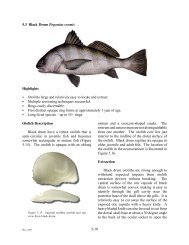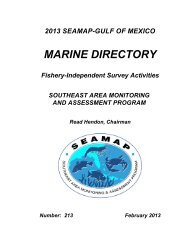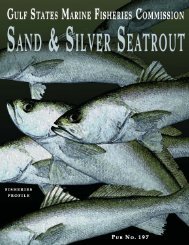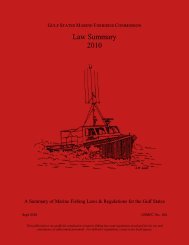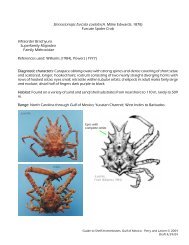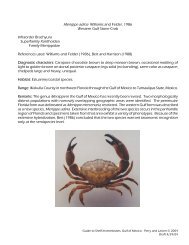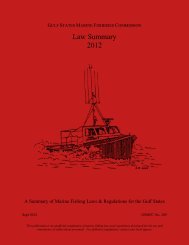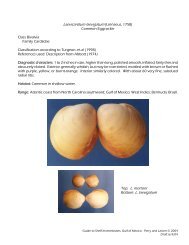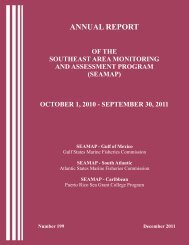Guidelines for Marine Artificial Reef Materials, Second Edition
Guidelines for Marine Artificial Reef Materials, Second Edition
Guidelines for Marine Artificial Reef Materials, Second Edition
You also want an ePaper? Increase the reach of your titles
YUMPU automatically turns print PDFs into web optimized ePapers that Google loves.
at five separate reef sites. Subsequent<br />
Texas reef deployments have utilized<br />
smaller vessels. In August 1995, Texas<br />
sank a tug boat at the Port Isabel/South<br />
Padre Island <strong>Reef</strong> followed by a 100 foot<br />
Navy surplus dive work barge at this same<br />
70 foot deep site. Both vessels have<br />
provided habitat to numerous reef fish<br />
species including Goliath grouper (TPWD<br />
unpublished data).<br />
From 1959 through mid April 2003 in Florida alone 280 miscellaneous boats and ships and 173<br />
barges (453 vessels total) ranging in overall length from 36 foot to 610 foot were intentionally sunk<br />
in state and federal waters off 28 coastal counties. An additional 34 ships, boats, and barges noted<br />
as wrecks lost through acts of war, accident, or storm events since 1926 are also utilized as fishing<br />
and diving sites. This total number of 487 vessels represents 24.6% of the 1,938 public artificial reef<br />
records in the Florida Fish and Wildlife Conservation Commission artificial reef database as of April<br />
1, 2003. During the period 1988-92, six east coast states, including North Carolina, Georgia, South<br />
Carolina, New Jersey, Maryland, and New York, spent a total of $149,000 on vessel preparation and<br />
deployment. During that same time period, only one recorded vessel deployment was reported from<br />
the Gulf (excluding Florida) with no expenditure of funds on vessels reported from Alabama,<br />
Mississippi, Texas, or Louisiana (Gregg and Murphey 1994).<br />
The steadily increasing popularity of sport diving over the past 25 years, combined with the increase<br />
in dive charter operations to meet demand, has been a major driving <strong>for</strong>ce in some local<br />
communities behind the procurement of vessels to sink as artificial reefs. Murray and Betz (1991),<br />
in a survey of 721 divers, commercial fishermen, sport fishermen, and environmentalists in Texas,<br />
North Carolina, and Florida, reported that 54.2% of all diving trips were to artificial reefs (with<br />
emphasis on vessels) versus only 15.5% of all recreational fishing trips. Additionally, 66.7% of all<br />
respondents identified as divers stated a preference <strong>for</strong> ships and barges over other artificial reef<br />
sites. The southeast Florida Counties of Miami-Dade, Broward, Palm Beach and Monroe have the<br />
highest concentration of vessels sunk as artificial reefs on the U.S. east coast or Gulf of Mexico.<br />
Off these counties, 9.81 million diving and fishing days were spent on or around artificial reefs in<br />
2001, with vessels comprising an important component of the sites visited (Hazen and Sawyer<br />
Associates, 2001). Bank loans of several hundred thousand dollars incurred by the Key Largo<br />
Chamber of Commerce as a result of providing financial assistance to the Spiegel Grove project in<br />
the Florida Keys are on track to be repaid within two years through the sales of souvenir medallions<br />
to thousands of divers who are diving the wreck (Spencer Slate, personal communication).<br />
The value of vessels as dive sites to some individual charter dive boat operators is substantial. In<br />
Beau<strong>for</strong>t, North Carolina, a single, multiple-boat dive charter operation reported an annual gross of<br />
$250,000 from trips targeting ship wrecks (Kurtis Gregg, personal communication). In April 1995,<br />
the cost to move a re-floated 150 foot dredge barge, cleaned and towed from South Carolina to<br />
southeast Florida and sunk as an artificial reef, was $100,000 (Ken Banks, personal communication).<br />
However, the annual value of a single ship sunk as a reef to the diving community in Broward<br />
County, Florida in 1995 was estimated at $144,000 (Ken Banks, personal communication). In<br />
Broward County alone the economic contribution in sales from a107 reef artificial reefs system that<br />
-23-




